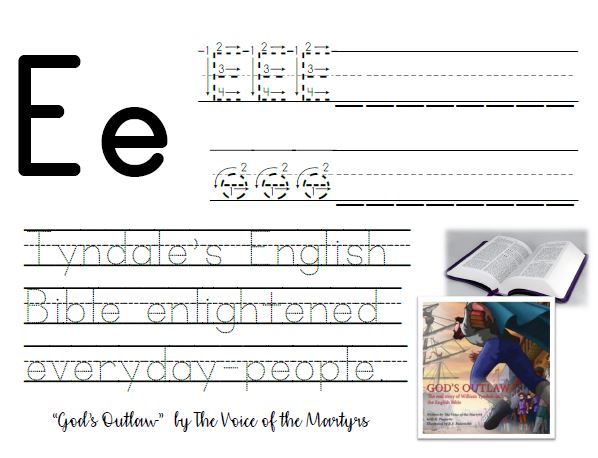Welcome! The following is the 5th in a series of 24 lesson plans, Learning the ABC’s through Literature, the 1st year. It was written especially for classroom use within a homeschool co-op, and was designed to teach the alphabet, over the course of a school year, using classic childrens literature. The books are primarily taken from the Five in a Row Curriculum by Jane Lambert, with several others added as well. The plans were designed to give just a little bit more, so it could be more usable within a classroom setting. Teachers questions, printables, craft ideas, classroom handouts, etc are included within all the lessons. This is geared towards a K-1st grade class. If you are interested in something similar for older children, the Learning through Literature series is a more developed concept of this same idea, geared towards 1st-3rd, and also uses mostly Five in a Row books. You can find it here, Learning through Literature, the 2nd year.
E: God’s Outlaw: The real story of William Tyndale and the English Bible
What do I need:
- English Bible
- Hebrew/Greek Bible
- Alphabet Stamps, Rubber Bands, Ink Pad, Paper
- Letter E Handwriting Sheet (printable version here)
- God’s Outlaw: The real story of William Tyndale and the
ENGLISH Bible
Introduce the Book
Begin the class with a Bible on your lap.
Show the Bible, and begin a discussion with these questions:
What is the Bible? (God’s word to us)
school? Or with your parents? (Honor your father and mother, for God so loved
the world)Explain that, even as young children, they can open up the Bible and read, “when I am afraid I will trust in God” (Psalms 56:3)… and even though you’re only 5
and 6, you can understand that, right?
or “bonjour, coma cava? (hello, how are you – in French)
or “hola! Coma estas? (hello, how are you – in Spanish)
Or what if I said,
“bonjour. Adjoudhui, je voudrais parler de la Bible. Tu comprend? (hello, today i would like to speak of the Bible)
follow God if I can’t read the Bible in my own language? **If you have or can borrow a Hebrew / Greek Bible, this would be a great illustration to show the class how the languages looked different, even the letters different – so they more fully understand that no one understood the Bible.
people to be able to understand the Bible. He said, “How can the people love God and follow Him if they don’t understand his word? God meant for his word to be read and understood. And so this is where our story begins.
Read the Story
Some dates to know/reference:
October 4, 1535 – First full English Bible published
Introduce the Printing Press with a Neat Craft:

Johannes Gutenberg Printing Press – was pretty special. In the late 1400s, Mr Gutenburg invented something pretty special. Let me show you how it worked.
Take one of your students names. Have he or she write out their name. This is often tedious job, especially at 4,5 and 6.
Have them write it out a few times, on a chalk board or in front of the class. Ask the student how it felt to have to write their name so much? Was it tiring? Did it take a long time?
Now, make a stamp out of the letters in the students name. You can do this by binding the individual letters together with a rubber band.
Then offer them the stamp, and tell them to write their name 5 times. Ask the student – was it easier? Faster? Of course. So this is what the printing press did for books. Lots of different books, but one of the first books that it was used for was the Bible.
Offer all the students time to make their names in stamps, as time permits.
Complete E handwriting sheet
 |
| Click here for printable version |

Click here to return to the Learning the ABC’s through Literature complete booklist and see the general instructions for each lesson.




